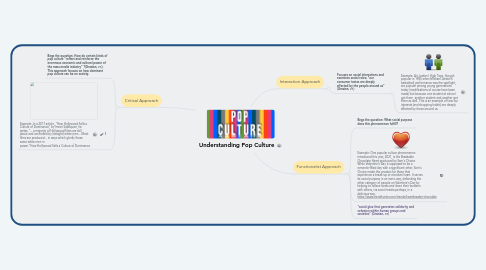Understanding Pop Culture
af Victoria Aguirre


1. Critical Approach
1.1. Begs the question: How do certain kinds of pop culture "reflect and reinforce the enormous economic and cultural power of the mass media industry" ?(Grazian, 21); This approach focuses on how dominant pop culture can be on society.
1.2. Example: In a 2017 article, "How Hollywood Sells a Culture of Dominance" by Imran Siddiquee, he writes "... a majority of Hollywood films are still about and controlled by (straight) white men... Most films are produced... in ways which glorify those same white men in power."How Hollywood Sells a Culture of Dominance
2. Interaction Approach
2.1. Focuses on social interactions and examines social roles; "our consumer tastes are deeply affected by the people around us" (Grazian, 21)
2.1.1. Example: Air Jordan I High Tops, though popular in 1985 when Michael Jordan's basketball performance was the spotlight, are popular among young generations today (modifications of course have been made) but because one student at school got them, another student and another got them as well. This is an example of how our interests (and shopping habits) are deeply affected by those around us.

